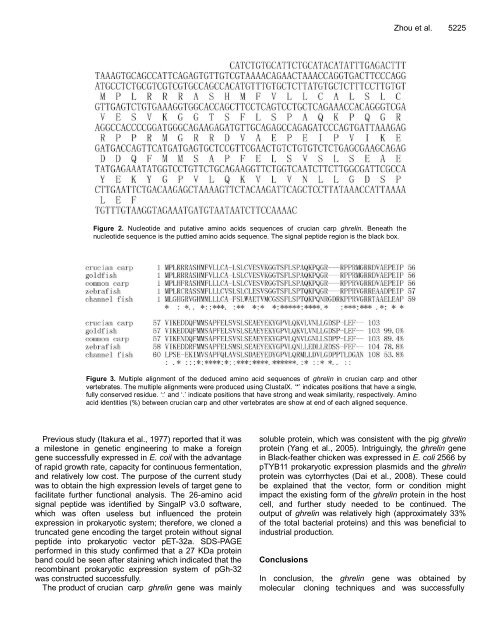Microbiology Research - Academic Journals
Microbiology Research - Academic Journals
Microbiology Research - Academic Journals
Create successful ePaper yourself
Turn your PDF publications into a flip-book with our unique Google optimized e-Paper software.
Figure 2. Nucleotide and putative amino acids sequences of crucian carp ghrelin. Beneath the<br />
nucleotide sequence is the puttied amino acids sequence. The signal peptide region is the black box.<br />
Figure 3. Multiple alignment of the deduced amino acid sequences of ghrelin in crucian carp and other<br />
vertebrates. The multiple alignments were produced using ClustalX. ‘*’ indicates positions that have a single,<br />
fully conserved residue. ‘:’ and ‘.’ indicate positions that have strong and weak similarity, respectively. Amino<br />
acid identities (%) between crucian carp and other vertebrates are show at end of each aligned sequence.<br />
Previous study (Itakura et al., 1977) reported that it was<br />
a milestone in genetic engineering to make a foreign<br />
gene successfully expressed in E. coil with the advantage<br />
of rapid growth rate, capacity for continuous fermentation,<br />
and relatively low cost. The purpose of the current study<br />
was to obtain the high expression levels of target gene to<br />
facilitate further functional analysis. The 26-amino acid<br />
signal peptide was identified by SingalP v3.0 software,<br />
which was often useless but influenced the protein<br />
expression in prokaryotic system; therefore, we cloned a<br />
truncated gene encoding the target protein without signal<br />
peptide into prokaryotic vector pET-32a. SDS-PAGE<br />
performed in this study confirmed that a 27 KDa protein<br />
band could be seen after staining which indicated that the<br />
recombinant prokaryotic expression system of pGh-32<br />
was constructed successfully.<br />
The product of crucian carp ghrelin gene was mainly<br />
Zhou et al. 5225<br />
soluble protein, which was consistent with the pig ghrelin<br />
protein (Yang et al., 2005). Intriguingly, the ghrelin gene<br />
in Black-feather chicken was expressed in E. coli 2566 by<br />
pTYB11 prokaryotic expression plasmids and the ghrelin<br />
protein was cytorrhyctes (Dai et al., 2008). These could<br />
be explained that the vector, form or condition might<br />
impact the existing form of the ghrelin protein in the host<br />
cell, and further study needed to be continued. The<br />
output of ghrelin was relatively high (approximately 33%<br />
of the total bacterial proteins) and this was beneficial to<br />
industrial production.<br />
Conclusions<br />
In conclusion, the ghrelin gene was obtained by<br />
molecular cloning techniques and was successfully

















